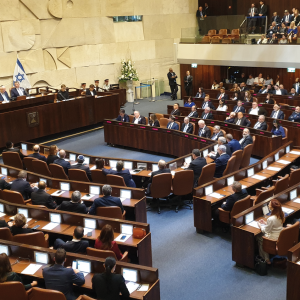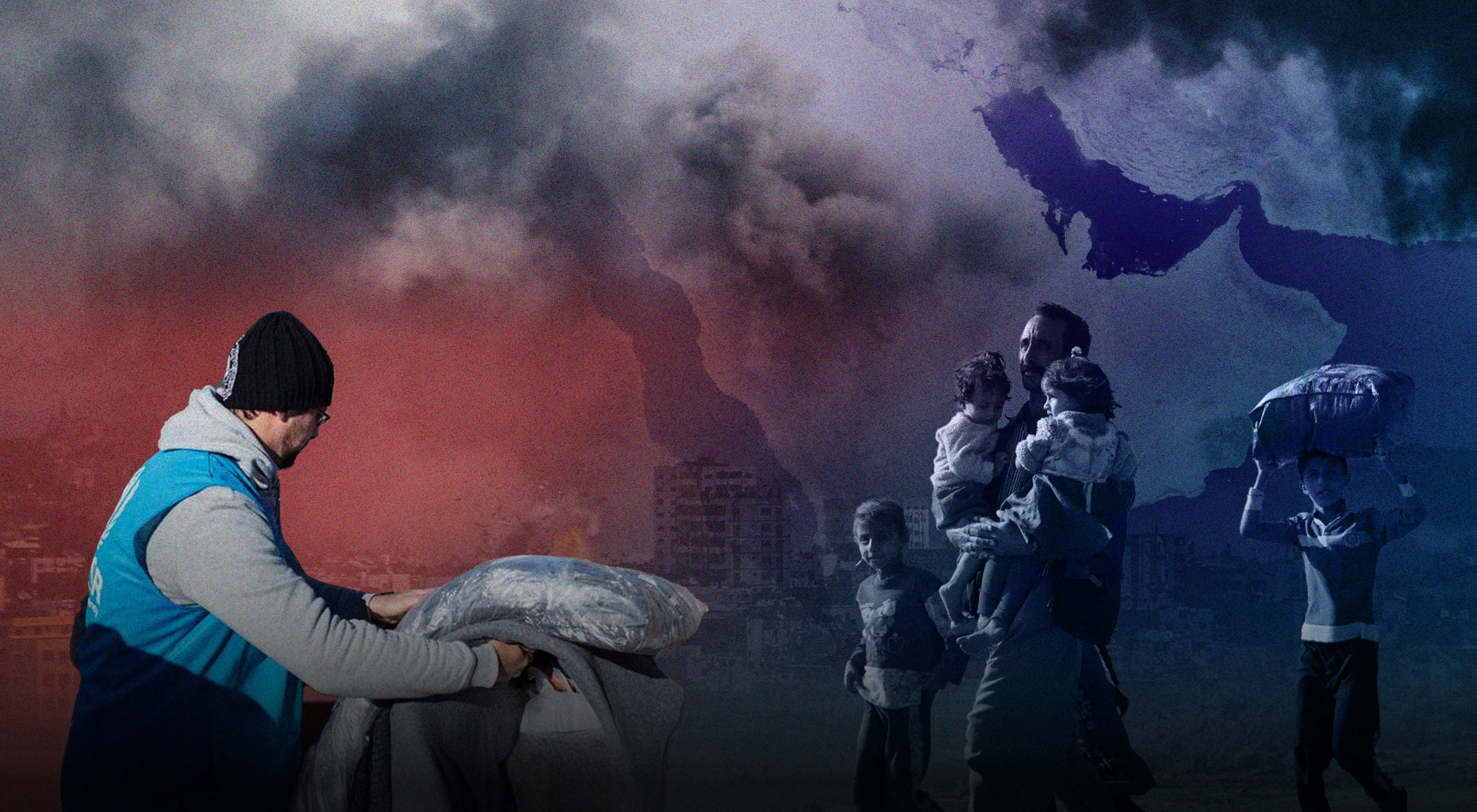Israel went to the polls on March 21, 2021, for the fourth time in a little more than two years. While the election did not lead to the crowning of a decisive winner, a new political constellation has emerged in the election’s aftermath, potentially offering a solution to the nearly two-year political impasse which has dominated Israeli politics.
Overview
Prime Minister Benjamin (Bibi) Netanyahu’s position and right-wing/religious/ultra-orthodox bloc have frayed under the weight of his considerable list of legal charges and his attempts to utilize his position to override any potential legal challenge. The previous government, formed by current Defense Minister Benny Gantz’s Kahol Lavan (Blue and White) in alliance with the Yesh Atid (There is a Future) party led by former television presenter Yair Lapid, crumbled due to Gantz’s desire to join an “emergency national-unity government” at the beginning of the coronavirus crisis. While Gantz and Netanyahu agreed to have a rotation deal whereby Gantz would become prime minister in November 2021, Netanyahu has fought at every turn to block this from happening.
Netanyahu’s resulting decisions and the consequent fourth-round election have changed the scope of Israeli politics away from traditional left-right divides and toward pro-or anti-Bibi camps. These have been termed the Gush Bibi (pro-Bibi Bloc of parties) and the Gush Shinui (“Change Bloc”), with the latter seeking Netanyahu’s ouster. In an interesting development, the Change Bloc introduced a significant right-wing opposition to Netanyahu from two quarters in particular: the secular nationalist Yisrael Beitenu with eight seats led by Avigdor Liberman, Netanyahu’s former bureau chief during his first term as prime minister, and Tikva Hadasha (“New Hope”) with four seats led by former Likud minister and challenger to Netanyahu, Gideon Sa’ar, who also brought over a cadre of Likud lawmakers opposed to Netanyahu’s dominance of the party.
Yisrael Beitenu and Tikva Hadasha have been joined in the Change Bloc by Yair Lapid’s centrist Yesh Atid with 17 Seats, his former ally Benny Gantz’s Blue and White with eight seats, the center-left Labor Party led by Meirav Michali with seven seats, and left-wing Meretz with six Seats led by Nitzan Horowitz. Netanyahu’s bloc has remained secure but has been unable to give him the majority he needed to form a government. His support outside the Likud bloc of 30 seats has been based on the party’s recent alliance with the ultra-orthodox parties Shas and Yahadut Hatora (“United Torah Judaism (UTJ)”), as well as the hard-right wing religious-nationalist party Hatziyonut Hadatit (“Religious Zionism”).
However, the most significant defection has been that of Naftali Bennett’s Yamina (“Right”) Party, which has positioned by its leader as a party between the two blocs, playing both against each other. Like Gideon Sa’ar and Avigdor Liberman, Bennett is another former Netanyahu aide who broke with the premier and founded his political movement combining right-wing politics and liberal economic policies as a platform designed to attract both secular and religious Israelis.
Israel’s Arab political parties have also undergone significant change. The Joint List, which in the previous round of elections saw the return of a record 15 representatives, has been riven more recently with internal squabbles among its constituent parties. These disputes led to the withdrawal of the Ra’am party – the political wing of the Islamic Movement led by Mansour Abbas – from the Joint List, which also includes the joint Jewish-Arab Communist Party Hadash, as well as Ahmed Tibi’s Ta’al, and the Arab Nationalist Balad.
While both the Joint List with six seats and Ra’am with four seats crossed the electoral threshold, there was a significant decrease in turnout in the Arab sector. Following the split, Ra’am under Mansour Abbas emerged as a party willing to position itself between the two political blocs to take up the mantle of Arab leadership. The party focused on gaining significant budgetary concessions for the Arab community and integrating them further into Israeli society.
The four camps
A survey of Israel’s complex socio-political map is needed to understand Israeli politics. While the state was founded under a primarily secular system, with the dominant Ashkenazi (Jews of central or Eastern European background) affiliated with the ruling Labor party, the political scene has since become far more diverse, so much so that President Reuven Rivlin recently described Israel as being divided into four main political camps: Secular Jews, Religious Zionists, the Ultra-Orthodox, and the Arabs. However, while that might make for easy classification, the reality reflects even more complex allegiances.
Among the national majority group of so-called secular Jews, there is a significant divide between a larger group seen as purely “secular,” with a Jewish identity demonstrated by residents of the Kibbutzim, Tel Aviv, and its affluent northern suburbs, and the “traditional,” primarily Sephardic or Mizrahi Jews, whose families immigrated mainly from Arab states and other Middle Eastern and West Asian states. These “traditional” Jews, while not strictly religious, demonstrate a more fluid definition of Judaism, combining a modern outlook with traditional practice, including observing Shabbat and Kashrut, the Jewish dietary laws.
This latter group, mainly the Sephardi middle and lower middle class, and Mizrahi Jews from “development towns” and former transit camps where North African Jewish immigrants were primarily settled in Israel in the 1950s, form the Likud Party’s electoral base. While the so-called “ethnic demon” – the social and economic gaps between Ashkenazi and Mizrahi Jews – has narrowed considerably in recent decades, it remains a politically contentious issue, one that is usually exploited during elections. Competing candidates often draw contrasts between the “center” of Israel, with its affluence and greater access to resources, and the economically depressed periphery primarily populated by Jews of Middle Eastern origin discriminated against during the early years of the state.
In recent years, the religious Zionist community (around 10-15 percent) emerged as the new Zionist elite, replacing the early socialist-secular Ashkenazi founders as the largest supplier of soldiers to elite combat units in the army. While the community is mainly right-wing in its political orientation and generally forms the backbone of the settler movement, there are several segments within the group best represented by two of its political leaders, Naftali Bennett and Betzalel Smotrich. Once united under the same political umbrella of the “Jewish Home Party,” Bennett and Smotrich have split, with Bennett founding the new Yamina Party, while Smotrich taking over the leadership of the far-right Hatziyonut Hadatit. The split in the religious Zionist leadership is manifested in the orientations and bases of support for the two political parties.
A multi-millionaire high-technology executive and former special forces officer, Bennett classifies as “religious lite.” He is married to a secular woman and has a liberal outlook on issues of religion and state while remaining hawkish on defense policy. Smotrich comes from a significantly more conservative background, with close ties to the religious Zionist rabbis, and is decidedly socially conservative with an extreme far-right ideology. Bennett’s moderation on issues of religion and state, in addition to his background, has made him the ideal partner for the centrist and right-wing opposition to Netanyahu to form an alternative government.
The Haredim (Ultra-Orthodox), who now amount to around 10-12 percent of Israel’s population, present arguably one of the most significant political and social challenges that Israel will face in the coming years. While there has been greater workplace integration, most Haredi men do not work. Instead, spend most of their time at the Yeshiva, studying Jewish texts, where they receive substantial government subsidies. The coronavirus crisis only highlighted the social fissures that may widen further, as many Haredim overtly disobeyed the state’s rules, highlighting their lack of integration and many of the sect’s overt disregard for the rules.
Much of this behavior has been tied to the close links between the Likud and Haredi parties, who remain an integral bloc within any potential Netanyahu coalition government. This has also caused a bump in secular support for parties such as Avigdor Liberman’s Yisrael Beiteinu, which has a decidedly secular and anti-Haredi bent.
The last main socio-political group in Israel is the Arabs, who constitute around 20 percent of the population and include groups such as the Druze, Arab Christians, and the majority of the Arab Muslim population. Perhaps, the most significant socio-political change in the past decade has been greater economic integration of the Arab population. In numerous surveys, this has been tied to the precipitous decline in Arab birthrates, from nearly eight children per family in 1960 to approximately three per family in 2016.
Greater economic integration and rising living standards have also brought about greater demands for political representation and less focus on issues related to the Palestinians. A more distinct Arab-Israeli identity has evolved that is less tied to Palestinian nationalism. Within this electoral space, greater political participation and expanded support for the Joint List can be seen. Mansour Abbas and his breakaway party have focused on bread-and-butter issues, most importantly greater funding for policing in Arab communities beset by gang violence and murder and increased funding for social services and infrastructure.
Implications
The emergence of a right-wing anti-Netanyahu bloc has shown the importance of personal politics and the decreased importance of ideological issues, most notably the Israel-Palestinian conflict. The ongoing political stalemate was not ideological but instead a referendum on the actions of Prime Minister Netanyahu. Significantly, much of the right-wing opposition to Netanyahu has revolved around his perceived disregard for democratic norms, his and his ally’s rhetoric against the judicial system and law enforcement, and his embrace of Jewish extremists, particularly followers of Meir Kahana.
These factors have impacted significantly on the recent election’s outcome. First, The Israeli “right” did perform well at the ballot box, winning 72 seats, or even 78 seats if Israel Beitenu, Avigdor Lieberman’s secular center-right party, is included. Notably, Israel’s march to the right includes strengthening the ultra-nationalist Hatziyonut Hadatit, whose list includes followers of Meir Kahane.
Second, if the fourth-round election was perceived as a referendum on Netanyahu’s leadership, the overall result was ambiguous. However, although the sitting prime minister retained a sufficiently solid base of support despite the corruption charges he faced, he could not continue as prime minister, not least because the very presence of Netanyahu prevented the formation of a stable government. Although the process to replace Netanyahu was difficult, the urgency needed by the anti-Netanyahu camp forced unlikely bedfellows together to oust the prime minister.
Yair Lapid and his Yesh Atid party led the process of piecing together a new government. However, he had to make significant compromises with uncomfortable bedfellows, from Meretz on the left to Yamina on the right. In the meantime, Lapid and Bennett agreed to a rotation deal by which Bennett would serve as prime minister for the first two years of the allotted four-year term while Lapid would serve as foreign minister. Under the agreement, Bennett is due to be replaced as prime minister by Lapid in August 2023, with the former being set to take the interior minister’s position at the same time.
While the Israeli Arab parties lost ground due to poor turnout and division among their ranks, this election proves that under the current circumstances, the only way to break the deadlock is the Zionist parties’ willingness to form a coalition or receive outside backing from Arab parties. The Mansour Abbas-led breakaway faction of the United Arab List (Ra’am) is striving to promote a civilian agenda at the expense of a more ideological-nationalistic one, heralding a blessed change in the Israeli system with both Arabs and Jews working toward supporting a healthier sense of “Israeliness.”
But perhaps the most significant change is the shifting attitude of Israelis of all political outlooks to political cooperation with the Arab parties. The fact that recent polling data from the Israel Democracy Institute (IDI) shows that 48 percent of Israelis are in favor of a government with outside support of Arab parties shows a significant change in public attitudes. But this change is mainly driven by the changing approach of the right-wing.
Among Jewish voters who identify with the right, 34 percent now favor a government supported by Arab parties, while among those who see themselves as a centrist, 58 percent back the idea. In February 2020, this was just 10 percent and 38 percent, respectively, according to an Israel Democracy Institute (IDI) survey. Jewish left-wing voters are 79 percent in favor of Arab party support, the poll found, while Arab voters are 65.5 percent in favor of Arab party participation in the government.
The impact of Mansour Abbas’ political maneuvering between the two main political blocs cannot be overstated. A recently leaked tape by Ayelet Shaked, Naftali Bennett’s number two, stated what many right-wing political commentators and far-right activists had voiced publicly in media outlets. The tape is purported to have claimed that Netanyahu’s negotiations with Abbas “legitimized” a potential center-left grouping sitting in government with Arab parties.
While there is no guarantee that this will happen, this potential scenario, and changing public attitudes, could eventually shape Israeli politics, not only in this electoral cycle but maybe for the coming decades. This could lead to more pragmatic and less dogmatic politics and a situation in which Arab parties and politicians will extract a political (and budgetary price) for their potential cooperation, enabling greater development and integration for their community.
The endgame
At least for the time being, the long and divisive reign of Benjamin Netanyahu, the dominant Israeli politician of the past generation, officially ended on June 21. The Knesset gave its vote of confidence to a precarious coalition government stitched together by widely disparate anti-Netanyahu forces. It approved the new government by just a single vote — 60 to 59, with one abstention.
In terms of political orientation, of the eight parties aiming to muster 61-strong support in the 120-member Knesset, three (Tikva Hadasha, Yamina, and Yisrael Beytenu) hold ideological positions to the right of Netanyahu. They are led by people who were ministers in past Netanyahu governments. Two of them (Yesh Atid and Blue and White) are centrist and are led by people who served as ministers in past Netanyahu governments. Another two (Labor and Meretz) are left-wing and account for just 13 of those 61 seats. One of them (the four-MK Ra’am) is a conservative Islamist party that Likud had also been wooing.
The 71-year-old Netanyahu’s 15-year run as prime minister, including the last 12 years uninterrupted, has been a watershed moment for politics in Israel. The outgoing prime minister has repeatedly claimed that the so-called “change government” is a “left-wing” concoction, invoking a description that Netanyahu has long used to try to demonize his political opponents. Furthermore, he has described the new eight-party coalition assembled to succeed him in office as a by-product of “the greatest election fraud in Israeli history and the history of democracies.”
Netanyahu has also warned that the new government will constitute a real danger to the State of Israel, its people, its territory, and its security. Though Netanyahu urged his fellow Likud MKs to “lay into” potentially wavering members of Yamina and New Hope to pressure them to withhold their support when the new coalition faced its Knesset approval vote, these maneuvers came to naught.
Naftali Bennett, a former ally of Netanyahu and now a bitter rival, has become prime minister, presiding over a diverse and fragile coalition with deep ideological differences. Netanyahu remains the head of the Likud party and will be the opposition leader. With Yair Lapid (a centrist leader who is set to take Mr. Bennett’s place after two years if the new government survives that long), Bennett has managed to tailor up an eight-party alliance ranging from left to right, secular to religious. They agree on little besides a desire to oust Netanyahu, the longest-serving leader in Israel’s history, and end Israel’s lengthy political gridlock.
In a speech delivered before the confidence vote, Bennett hailed his unlikely coalition as an essential antidote to an intractable stalemate. “We stopped the train before the abyss,” he said. “The time has come for different leaders, from all parts of the people, to stop this madness.” Before and after the fragile new government was announced, Netanyahu and his right-wing allies labored hard to break it before taking office. They applied intense pressure on right-wing opposition lawmakers, urging them to abandon their leaders and reject a coalition that includes centrists, leftists, and an Arab Islamist party.
But given Netanyahu’s record as a shrewd operator who has defied many previous predictions of his political demise, it would be premature to write off his career. Despite being out of government and standing trial on corruption charges, he remains a robust and influential player who will probably try to drive wedges between the coalition parties. Israel has held four inconclusive elections in two years and has gone much of that time without a state budget, fueling disgust among voters with the nation’s politics. No one could cobble together a Knesset majority after the first two contests, and the third produced an unwieldy right-center coalition that collapsed after months in recriminations.
The new coalition proposes to set aside some of the most challenging issues and focus on rebuilding the economy. Some of its factions hope to see a movement away from the social policies that favored the ultra-Orthodox minority, whose parties were allied with Netanyahu. But Bennett’s party, which has a Zionist-religious base, is wary of alienating the Haredim, as the ultra-Orthodox are known in Hebrew. Supporters also hope for a return to a long tradition of Israel cultivating bipartisan support in the United States. During Netanyahu’s reign, Israel has grown more aligned with Republicans and was embraced by Donald Trump, the former president. It remains uncertain where relations could go with President Biden.
Whether the new government will avoid another gridlock or crumble under the weight of its contradictions remains to be seen. The recent 59-59 tied vote on the proposed “Citizenship and Entry into Israel” Law, which came after an all-night session of the Knesset, marked an immediate major setback for Prime Minister Bennett. The result came despite Bennett’s efforts to find a compromise between his hardline Yamina party and the dovish factions in his disparate coalition. The result was a defeat in a vote that Bennett reportedly described as a referendum on the new government. This vote has signaled that the road of political survival will be paved with intense challenges for the new Israeli governing coalition.








